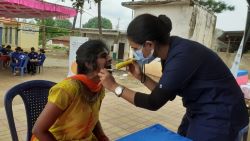In the current scenario, Lung cancer is shedding its smoker’s disease label, as more number of non-smokers are being diagnosed, challenging the traditional assumptions about the disease’s causes and forcing a rethink among the medical professionals and the public alike.
A silent transformation
Lung cancer is increasingly affecting non-smokers, with one in five cases globally occurring among the non-smokers. The trend is particularly striking among the younger adults and women, highlighting the growing impact of environmental, lifestyle and genetic factors on cancer risk.
The question is no longer limited to “Do you smoke?” but rather, “What are you exposed to every day?”
Breathing in Danger: Air Pollution’s role
In cities across the world, simply stepping outside has become a health risk. Urban air is thick with microscopic pollutants – PM2.5 particles, vehicle emissions, industrial smoke, and construction dust, all of which can lodge deep inside the lungs. Over time, these particles cause chronic inflammation and DNA damage, laying the groundwork for cancerous growth. Studies show that long-term exposure to polluted air can carry nearly the same risk as light smoking. The irony is stark: even those who consciously avoid cigarettes may unknowingly inhale the equivalent of several a day just by breathing polluted air.
The hidden hazards within homes
While outdoor pollution grabs headlines, indoor air can often be worse. Poorly ventilated kitchens, especially those using biomass fuels or cooking on high flames, release toxic fumes and fine particles that accumulate over years. Radon gas, a naturally occurring radioactive gas that seeps through floors and walls, is another invisible culprit linked to lung cancer in non-smokers. Even small lifestyle choices, like burning incense sticks, candles, or using aerosol-based cleaning products, can introduce carcinogens into enclosed spaces. We tend to view our homes as safe havens, but for many, prolonged indoor exposure becomes a slow and silent health hazard.
Genetic links and Molecular Triggers
Not all cases stem from the environment. Researchers have found specific gene mutations – such as EGFR, ALK, and ROS1 – that are more common among non-smokers, particularly women. These mutations cause cells in the lungs to multiply uncontrollably, leading to cancer even without external triggers. This discovery has revolutionized treatment approaches. Patients with these mutations often respond better to targeted therapies – precision medicines designed to attack only cancerous cells – offering improved outcomes and fewer side effects compared to traditional chemotherapy.
Occupational and Lifestyle Exposures
Workplace environments can also contribute to the rising trend. Prolonged exposure to asbestos, diesel exhaust, arsenic, or other industrial chemicals significantly raises lung cancer risk. Even low levels of second-hand smoke – inhaled passively over years in homes or offices – remain harmful. Modern lifestyles add their own layer of risk. Sedentary habits, processed diets, and chronic respiratory infections can weaken lung health, making the body more vulnerable to environmental damage.
Breaking the Stigma
One of the biggest hurdles for non-smoking patients is stigma. The moment someone hears “lung cancer,” the assumption often follows that the person must have smoked. This misplaced judgment not only affects patients emotionally but can also delay diagnosis, as many non-smokers dismiss persistent coughs or breathlessness, believing cancer couldn’t happen to them. The narrative must change: lung cancer is not a smoker’s disease anymore – it’s a societal disease shaped by the world we live in.
Recognising early warning signs
Lung cancer detected early can often be treated successfully, yet non-smokers rarely see themselves at risk. Common symptoms like a long-standing cough, chest pain, fatigue, hoarseness, or unexplained weight loss are frequently mistaken for minor infections. Regular health checks and low-dose CT scans for people with high environmental exposure or family history can help detect lung changes before they become life-threatening. Awareness and vigilance are the first lines of defence.
Prevention starts with Awareness
Addressing this rise requires collective action. Cleaner urban planning, strict air quality regulations, and better home ventilation can all make a measurable difference. On an individual level, ensuring proper airflow while cooking, reducing use of synthetic sprays, maintaining indoor plants, and wearing protective masks in polluted areas are simple but effective steps. Good lung health also depends on lifestyle choices – staying active, eating antioxidant-rich foods, and avoiding prolonged exposure to smoke or fumes.
A Reality we can’t Ignore
The rise in lung cancer among non-smokers is a stark reflection of how modern life is reshaping disease patterns. It’s not about fear, but awareness – understanding that invisible risks exist even without cigarettes.
By recognizing these triggers early and acting consciously, we can begin to reclaim control over what we inhale, how we live, and ultimately, how we protect one of our most vital organs – our lungs.
Dr. Nandish Kumar Jeevangi , Sr. Consultant, Medical Oncology , HCG Cancer Center – Gulbarga
 Newspatrolling.com News cum Content Syndication Portal Online
Newspatrolling.com News cum Content Syndication Portal Online






